Vietnamese Coconut Pandan Jelly Dessert
A soft creamy and wonderfully fragrant sweet jelly dessert that is packed full of rich coconut and Pandan flavor, this Vietnamese Pandan coconut jelly recipe will soon become a family favorite!
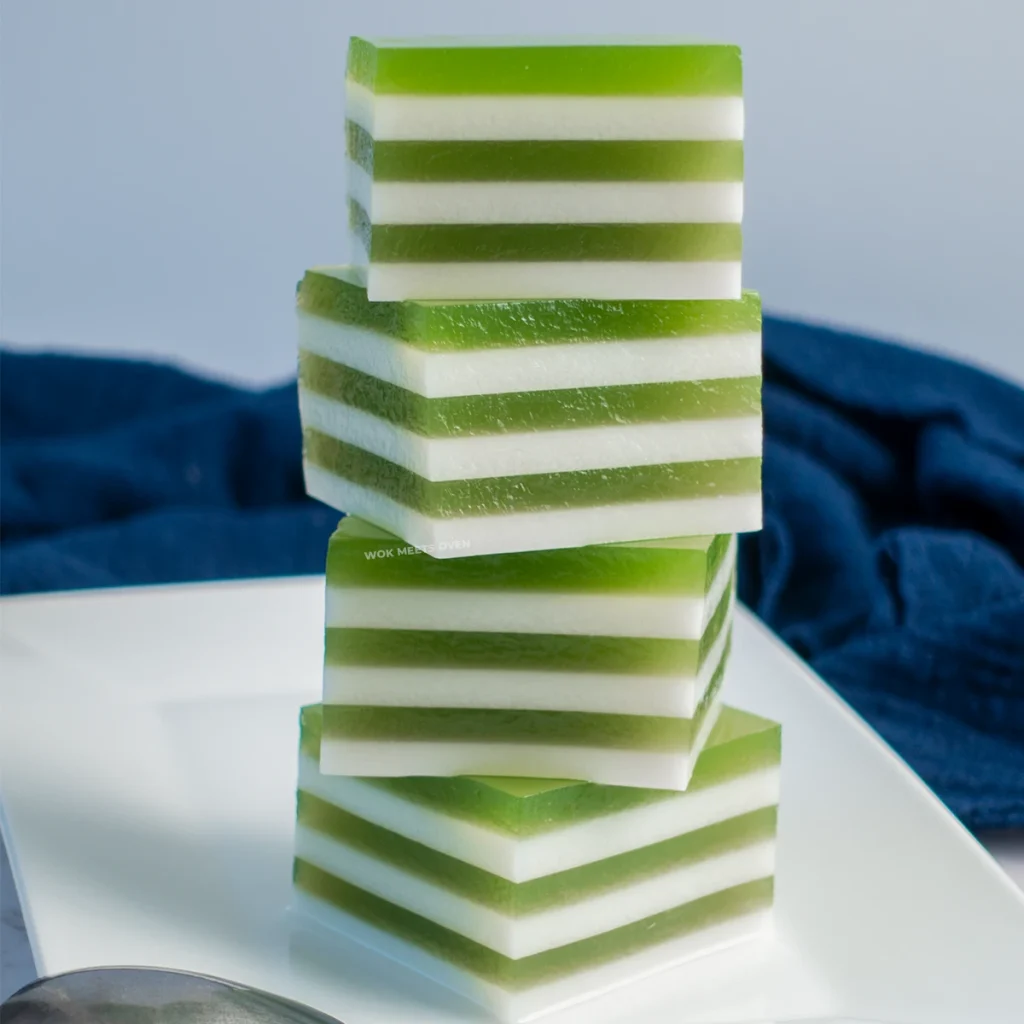
What Is Vietnamese Coconut Pandan Jelly Dessert?
When I was a little boy, my mother loved to whip up some Vietnamese coconut Pandan jelly dessert at home along with her signature Vietnamese coffee and coconut jelly dessert as well.
Piece after piece, bite after bite, I just couldn’t get enough of my mother’s Vietnamese Pandan coconut jelly.
I remember my mother would make several containers worth of these Asian desserts and soon enough within 1-2 days, there would be nothing left. It was that good!
Now as I grow older, I’m happy to say that I’m able to recreate this Vietnamese dessert from my childhood.
Vietnamese coconut Pandan jelly dessert also known as thạch rau câu lá dứa in Vietnamese is a famous Vietnamese jelly dessert that is comprised of coconut milk, Pandan juice, and agar-agar powder. The jelly is stacked in several layers on top of each other to create a beautifully eye-catching dessert.
But the dessert isn’t just beautiful to look at, it actually tastes just as good as it looks. Each layer in the jelly dessert brings a unique blend of flavors. The Pandan layer is super fragrant while the coconut layer is extra creamy and smooth. Combined, both of them will wreak havoc on your weight-loss diet, as you won’t be able to stop eating at just one piece!
In addition, this Vietnamese Pandan coconut agar agar recipe is extremely easy to make as well and only requires a few ingredients. I was actually surprised by how simple and easy it was to make Pandan jelly with coconut milk the first time I made it. In less than an hour, I had a delicious dessert ready to be devoured (not including cooling time in the fridge of course).
If you’re looking to wow your family and friends then keep reading to learn how to make coconut Pandan jelly.
What is Pandan?
Pandan also known as lá dứa in Vietnamese is a plant that is often seen being grown in southeast Asia. These plants are prized for their aromatic leaves that grow from the plant and regenerate after being cut. The leaves of the Pandan plant produce a very fragrant and aromatic smell and are often used in a lot of Southeast Asian desserts.
Often in Vietnamese dessert recipes, you will see this ingredient being used by having its leaves either thrown directly into the dessert such as in Vietnamese corn pudding (Chè Bắp) and Vietnamese corn milk (Sữa Bắp), or having its juices extracted and then combined with the ingredients such as Pandan jelly dessert.
What is Agar-Agar Powder?
Agar-agar powder is a thickening agent often used in a lot of jelly recipes such as my milo and coconut jelly dessert recipe. The agar-agar powder comes from seaweed, mainly red algae, making it a great vegetarian and vegan-friendly alternative to gelatine which is derived from animals. Unlike gelatine, agar-agar produces a firmer and crunchier texture, making it an ideal thickening agent to use for recipes that involve layering such as my pandan coconut milk agar agar jelly recipe found here or the popular Vietnamese coffee and coconut jelly dessert.
If you prefer a more softer type of texture then check out my coconut jelly recipe.
Ingredients
Agar-agar liquid mixture:
- 25g of Agar-agar powder
- 1.6L of Water
- 300g of White granulated sugar
- 1/4 tsp of Table salt
Coconut Layer:
- 400ml of Coconut milk
- Combine 850 ml of the agar mixture with the coconut milk
Pandan Layer:
- 50g of Pandan leaves
- 500ml of Water
- Combine 750 ml of the agar mixture with the Pandan juice
- 1-2 drops of Pandan extract/Essence (optional)
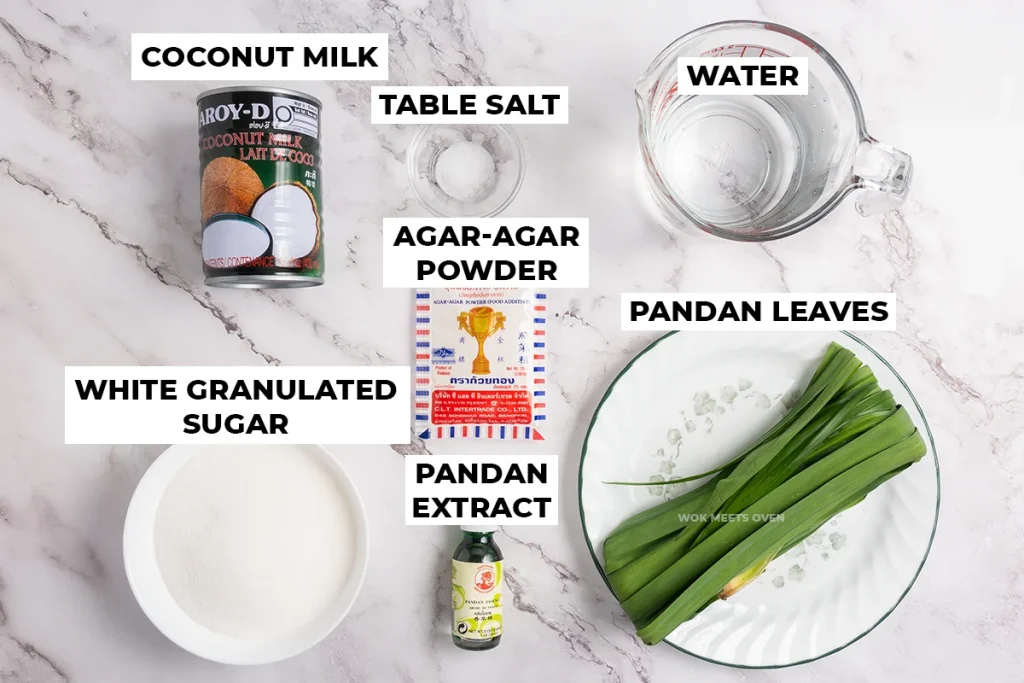
Ingredient Notes
Agar-Agar powder: For this recipe, I used a popular Thai brand of agar-agar powder that you will typically find being sold at Asian supermarkets, however, most agar-agar powers will work as well with this recipe.
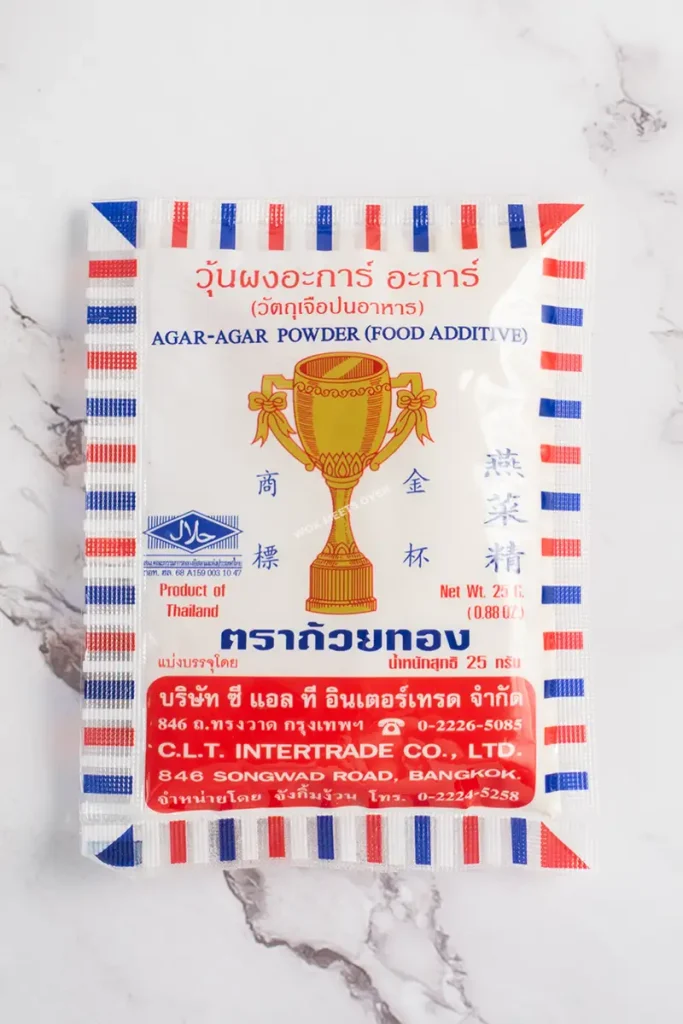
Coconut milk: For the coconut milk you can opt for either full-fat or reduced-fat coconut milk. The full-fat coconut milk will be thicker and more creamier at the expense of more calories while the less fatty coconut milk will be more softer and runnier.
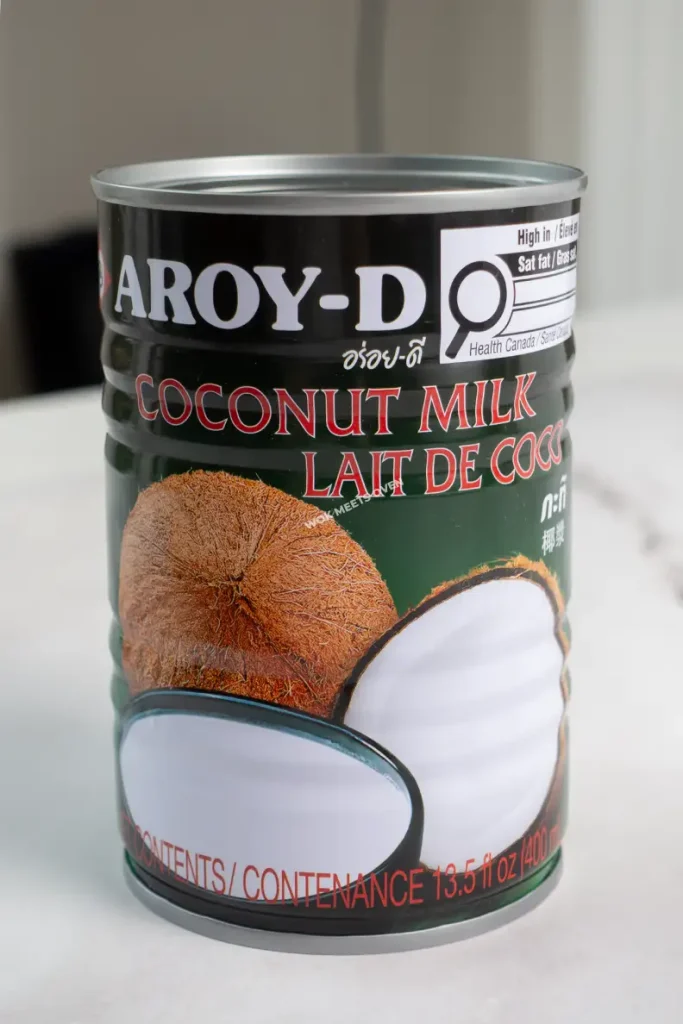
Pandan leaves: Pandan leaves come from the Pandan plant, a widely grown plant in Southeast Asia that is often used in a lot of Southeast Asian cuisine as a flavoring agent. The leaves and extract from the plant provide a very fragrant and aromatic smell to dishes and are often used in a lot of Vietnamese desserts. You can find Pandan leaves being sold at most Asian grocery stores in both fresh and frozen form. My parents are actually growing this plant at home as I write this.
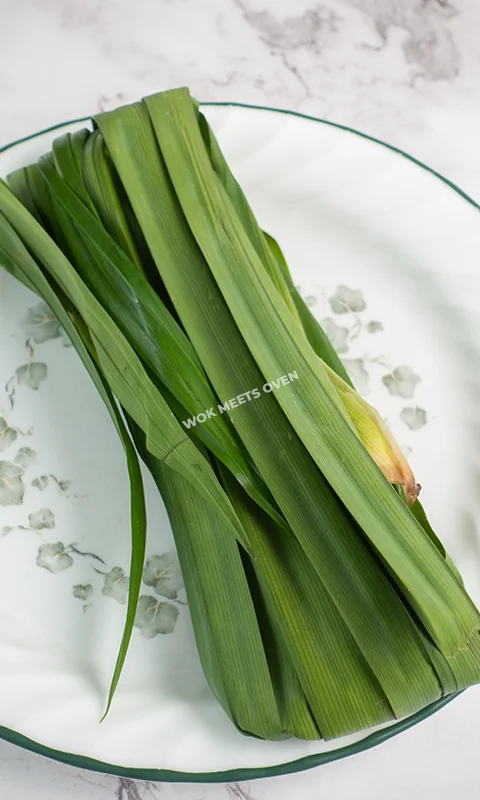
Pandan extract/essence: Pandan extract or essence is a more concentrated form of the Pandan leaves that you can directly add to your dishes without having to blend and strain out the liquid, unlike the leaves. The Pandan extract often will give a very greenish color to whatever you’re adding it to, especially the little bottles of Pandan extract. I’m using Pandan extract in this recipe to add a little boost of Pandan flavor to the dessert in addition to giving it a nice green color to the jelly. Now one distinction should be made, you will often find cans of “Pandan extract” but it’s really more of like Pandan juice rather than extract.
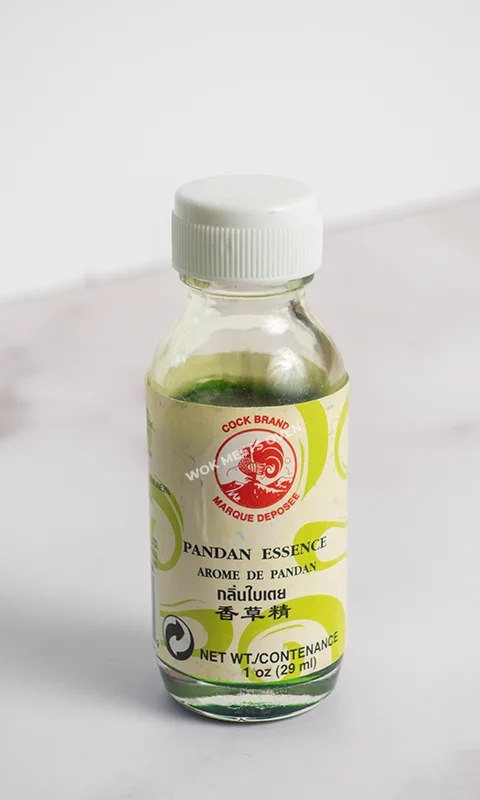
Substitutions
- Coffee: If you don’t like pandan for some reason then a good alternative that goes great with coconut milk is coffee, especially Vietnamese coffee.
- Milo: Milo is a chocolatey malt drink mix that goes great with coconut milk. I have a recipe for coconut milk milo jelly that you can check out on my site.
- Mango: Mango is another popular choice that you’ll often see being used for jelly desserts. They taste amazing by themselves or even better when layered with coconut milk.
How to Make Vietnamese Pandan Coconut Dessert
- To start off, pour the agar agar powder and sugar into a pot of water (1.6L) and let it soak for a few minutes (approximately 10-15 minutes) after whisking it with a whisk. You will end up with 1.6 Litres of agar-agar liquid mixture, which will be divided between the coconut milk and pandan juice layers later on.
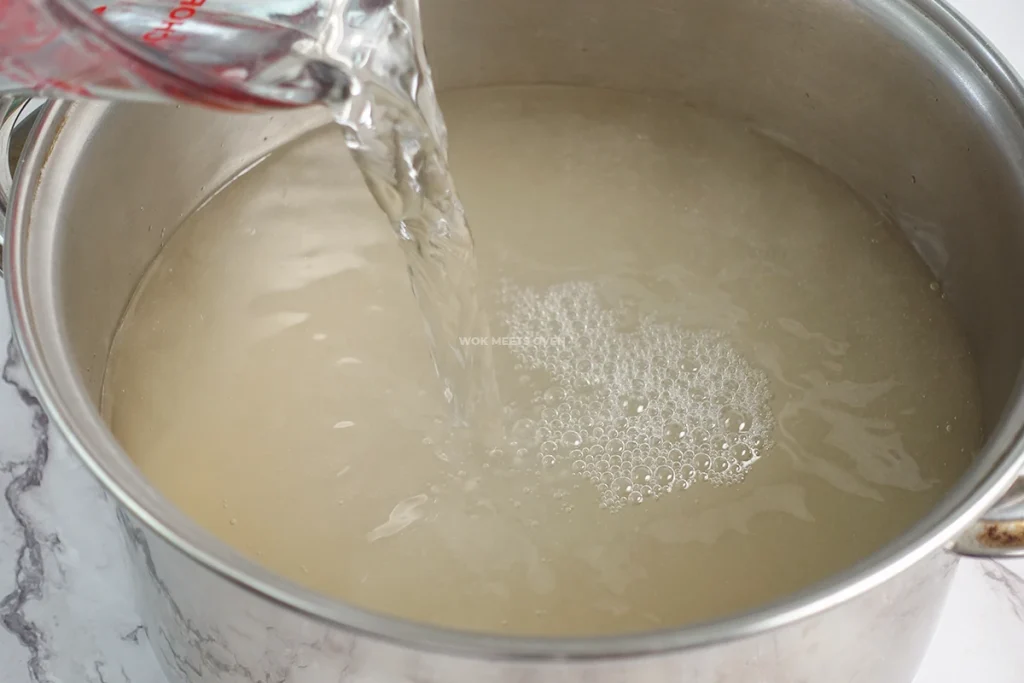
- In another pot pour the coconut milk onto the pot and set it aside.
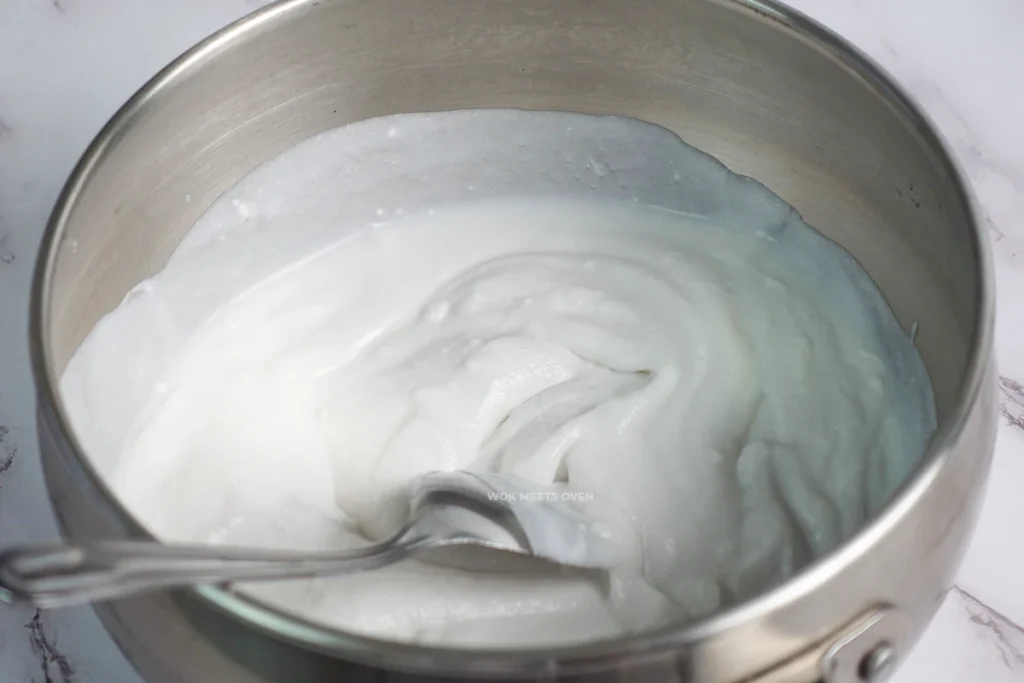
- Now add the Pandan leaves and 500ml of water into a blender and blend everything together. Then strain out the Pandan juice and pour it into a pot. Add 1-2 drops of pandan extract/essence and mix everything well together and set it aside.
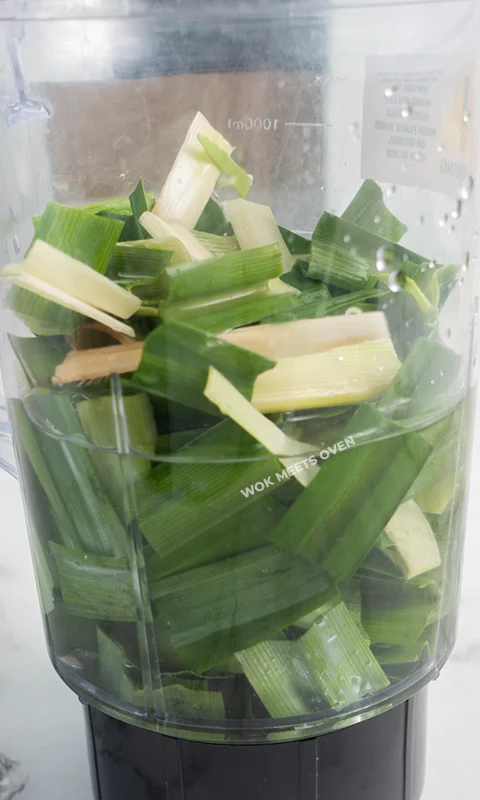
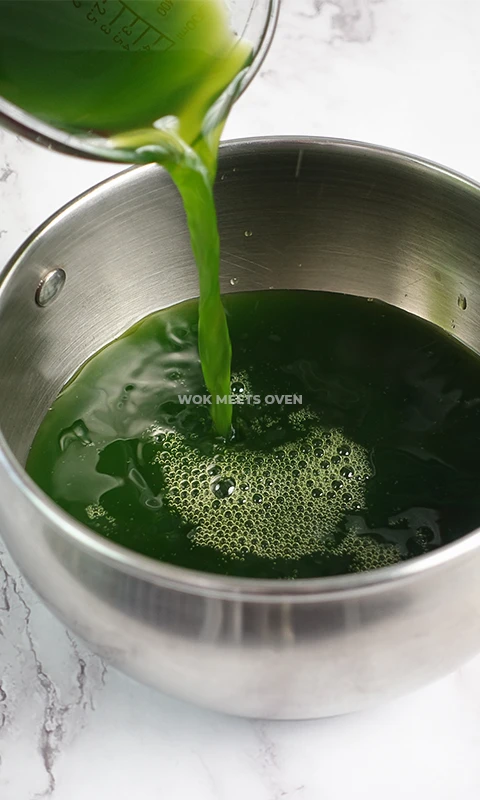
- Next, heat up the pot with the agar agar powder from earlier until it boils and then turn off the stove.

- Now pour out 850 ml of the agar agar liquid into the pot with coconut milk and 750 ml of the agar agar liquid into the pot with the Pandan juice and mix well together.
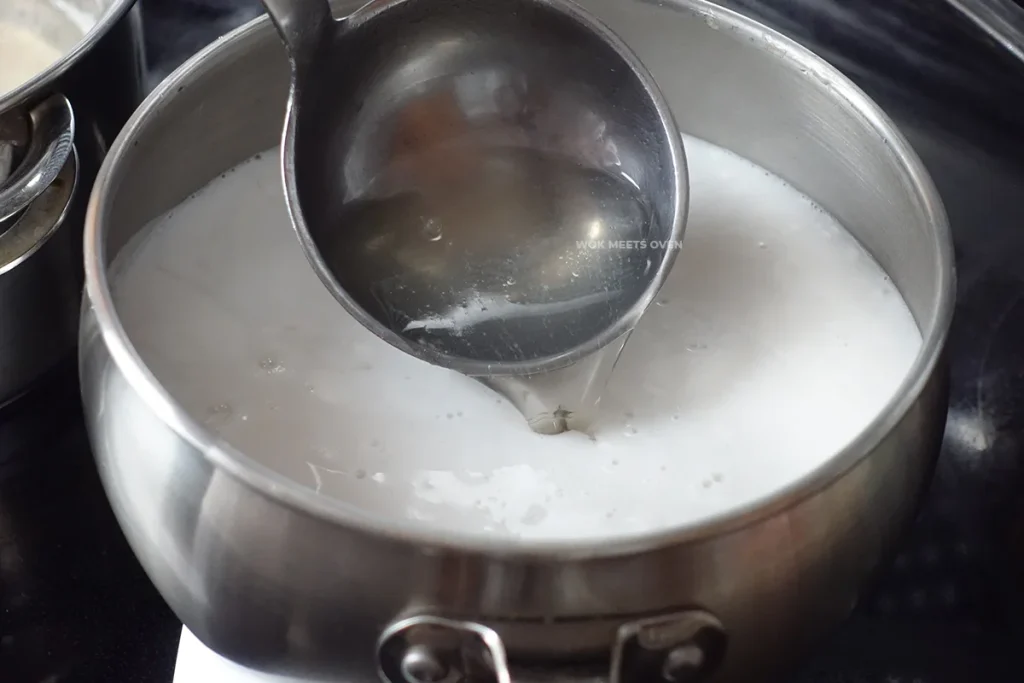
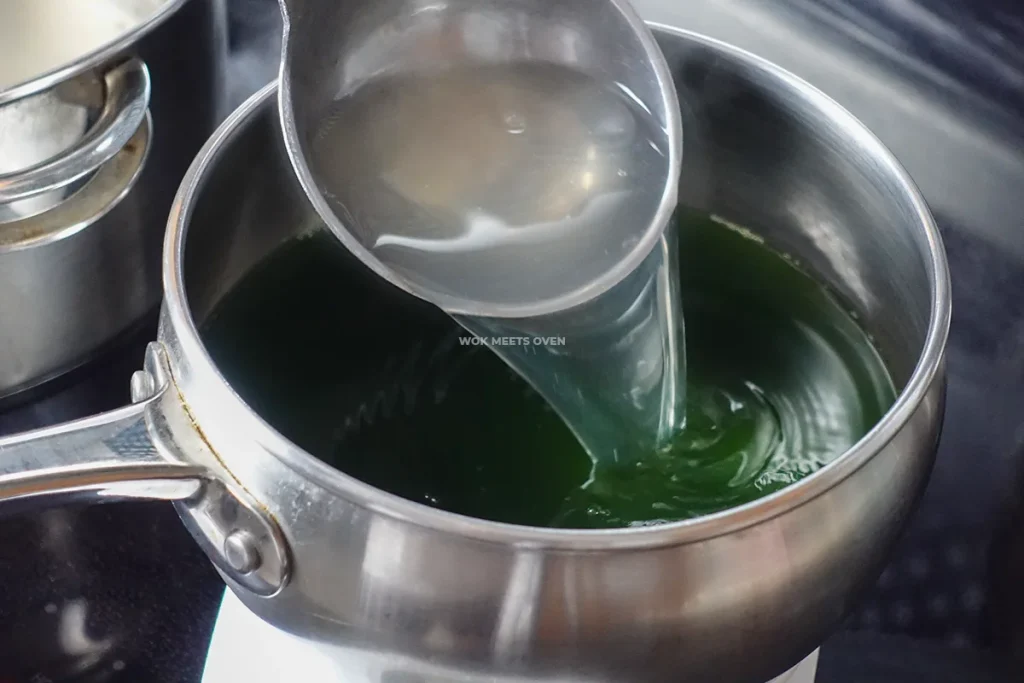
- Place both of the pots onto the stove and turn on the stove. Heat up the pots and let them simmer while constantly stirring the pots.
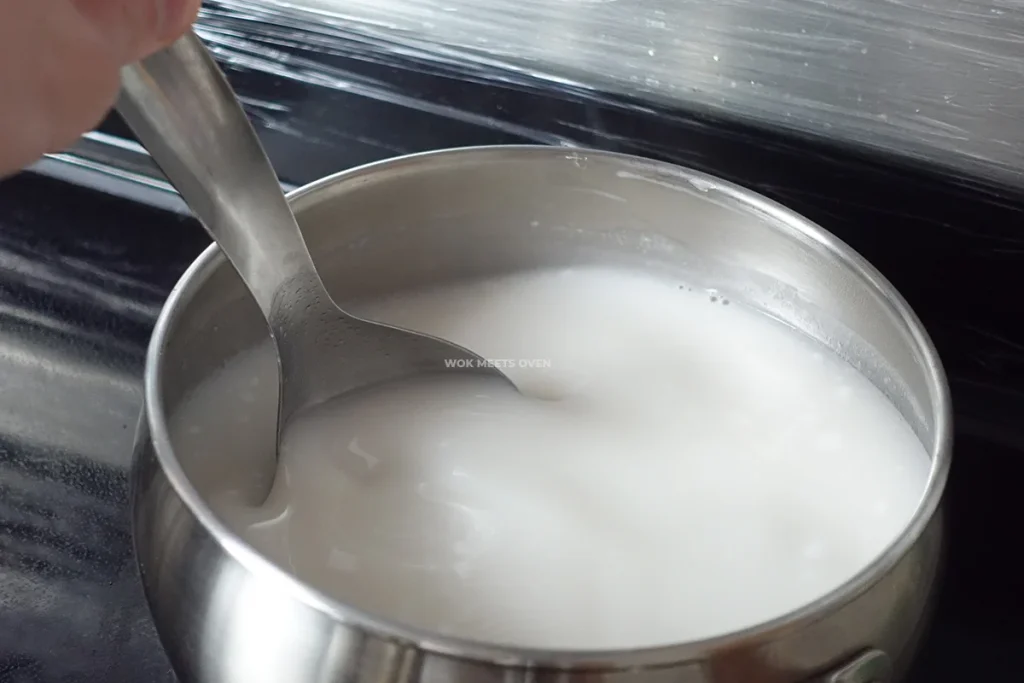
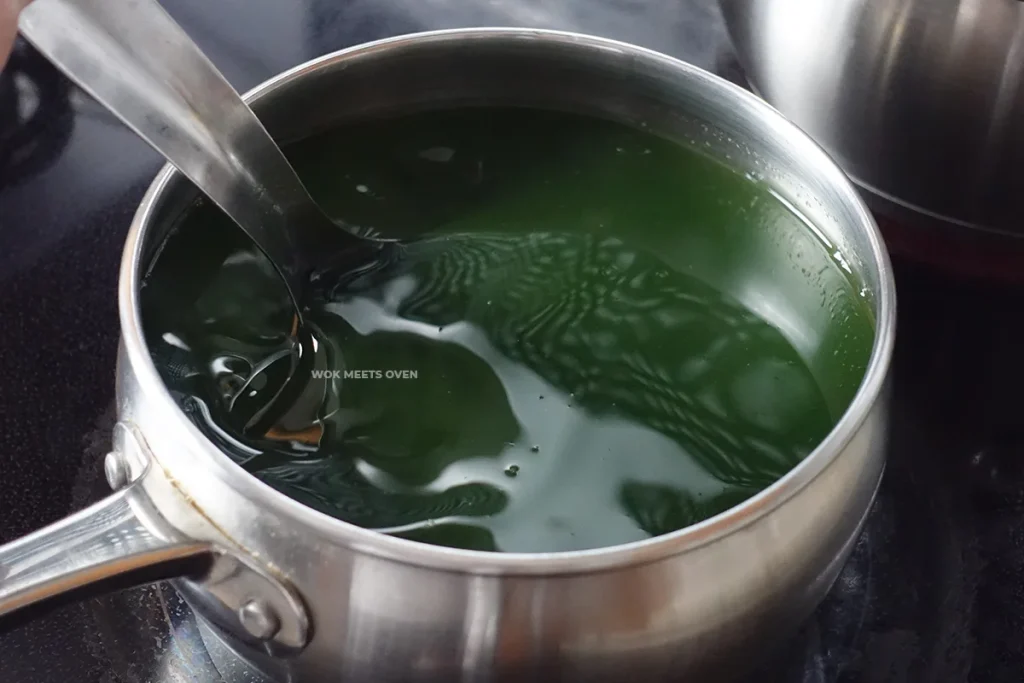
- Once they start to simmer, reduce the heat to low to keep both of the pots warm.
- Now use a large measuring cup, and pour out around 200ml of the liquid from the Pandan juice pot onto a glass container. This will be our first layer.
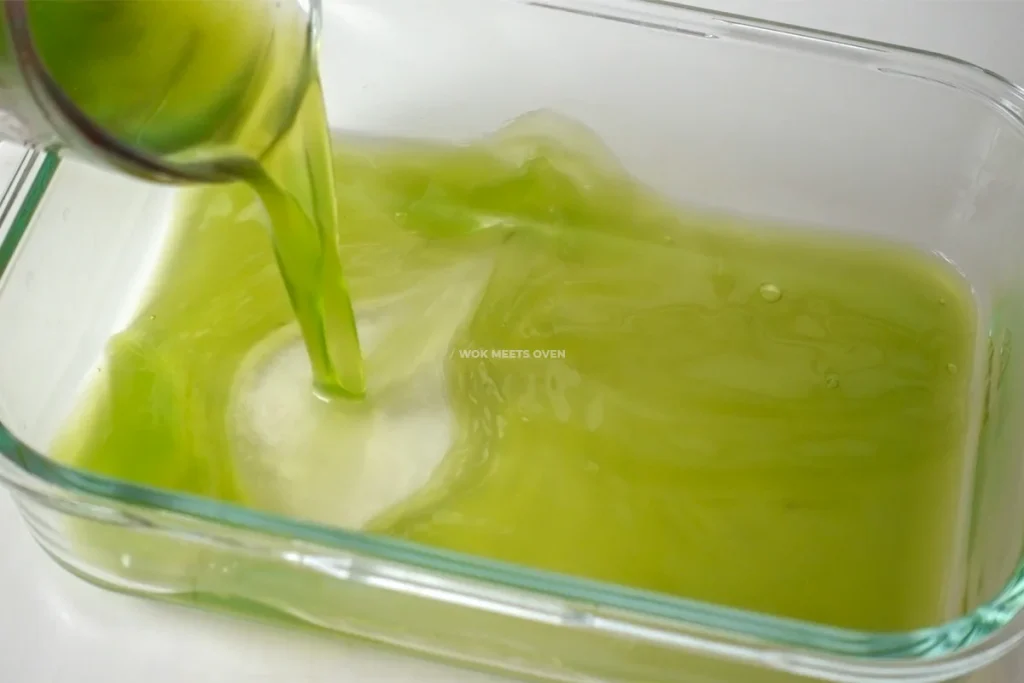
- Now using a timer such as an app on your phone, time it for 10 minutes to allow the first layer to solidify. At the end of 10 minutes, check for firmness by gently tapping on the layer and see if it’s somewhat firm. If it’s firm, then you can proceed to the next step. If it’s not firm yet, give it some more time to become firm, and then adjust your timer countdown time accordingly for pouring out future layers.
- Next, pour out 200ml of the coconut liquid from the coconut pot on top of the Pandan layer and let it rest for about 10 minutes to solidify or whatever time you deemed was necessary from the previous step.
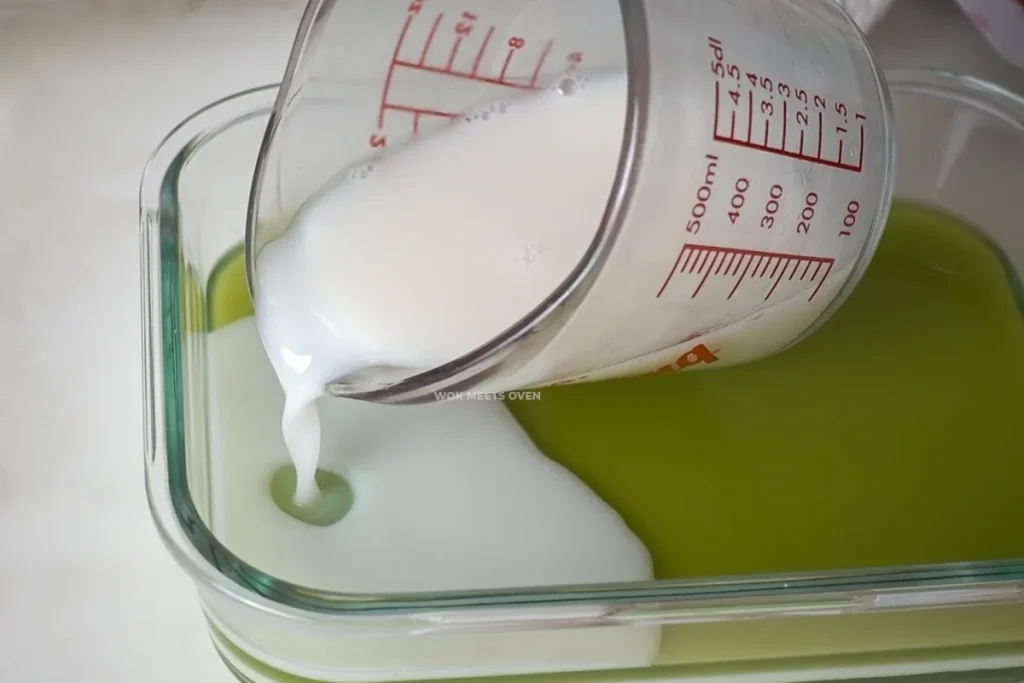
- Repeat these two steps until you have 6 layers in total (3 Pandan layers and 3 coconut layers).
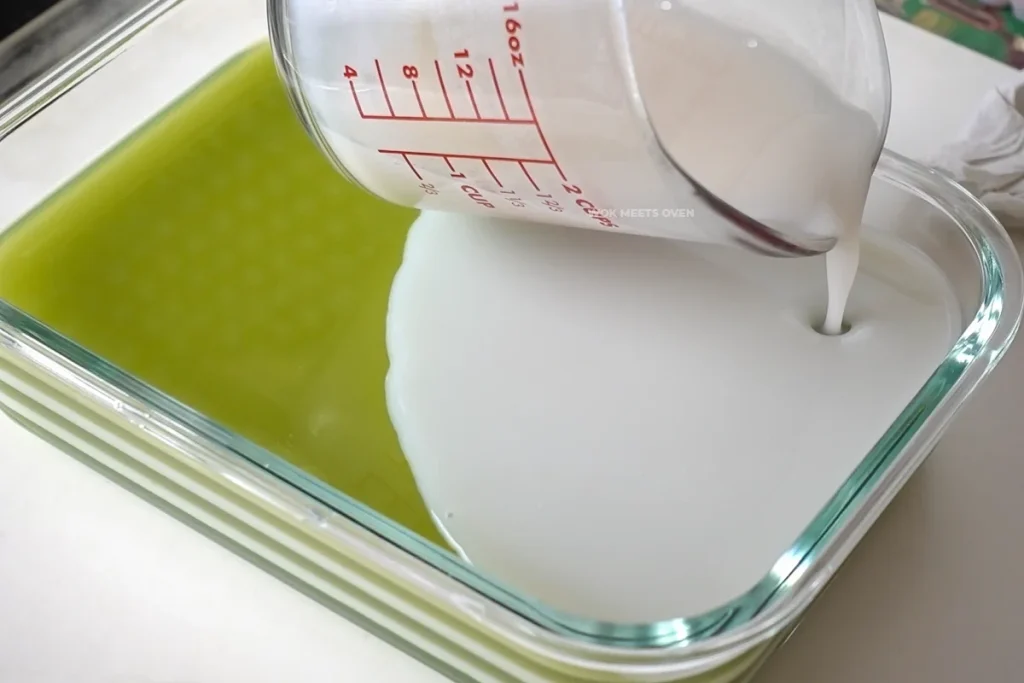
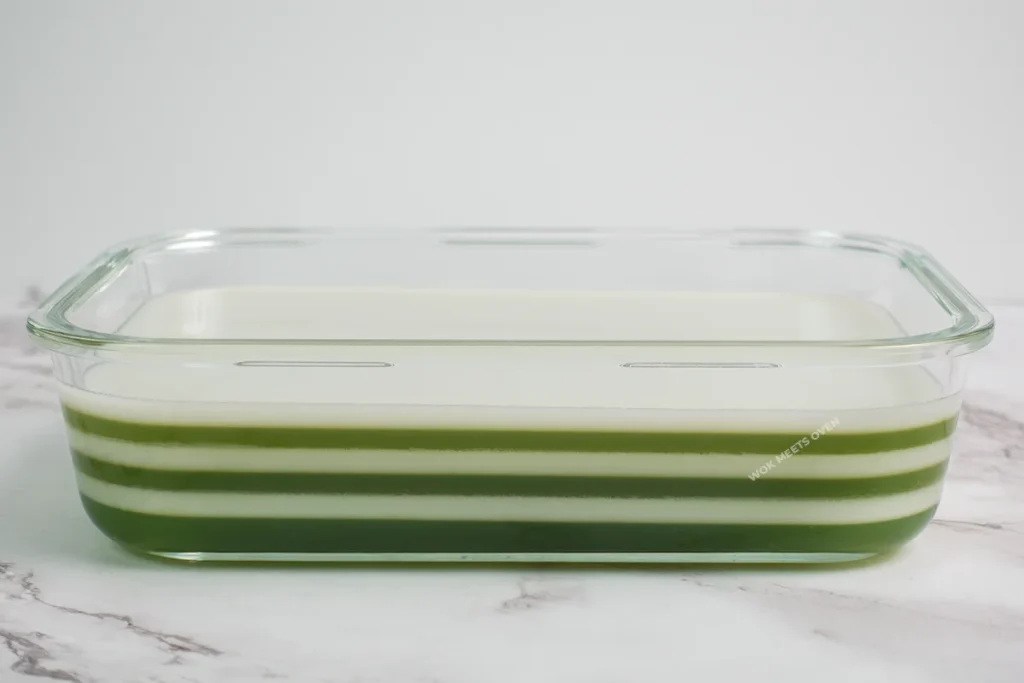
- Leave the jelly outside until it cools down and then cover it with a lid and store it in the fridge to cool down, ideally overnight before serving or at least 4 hours before consuming.
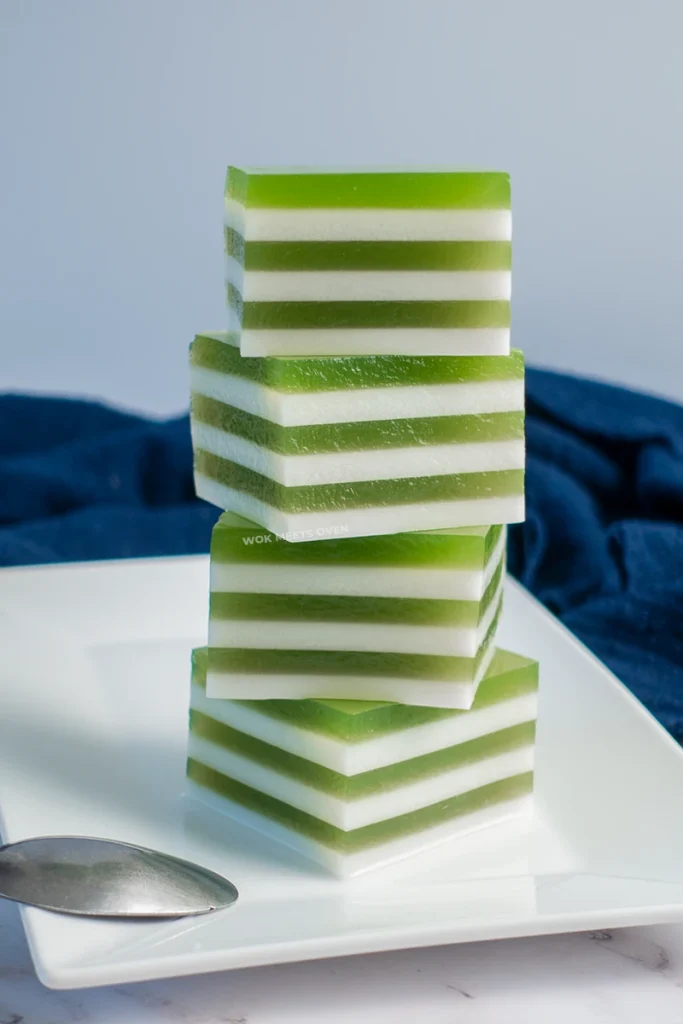
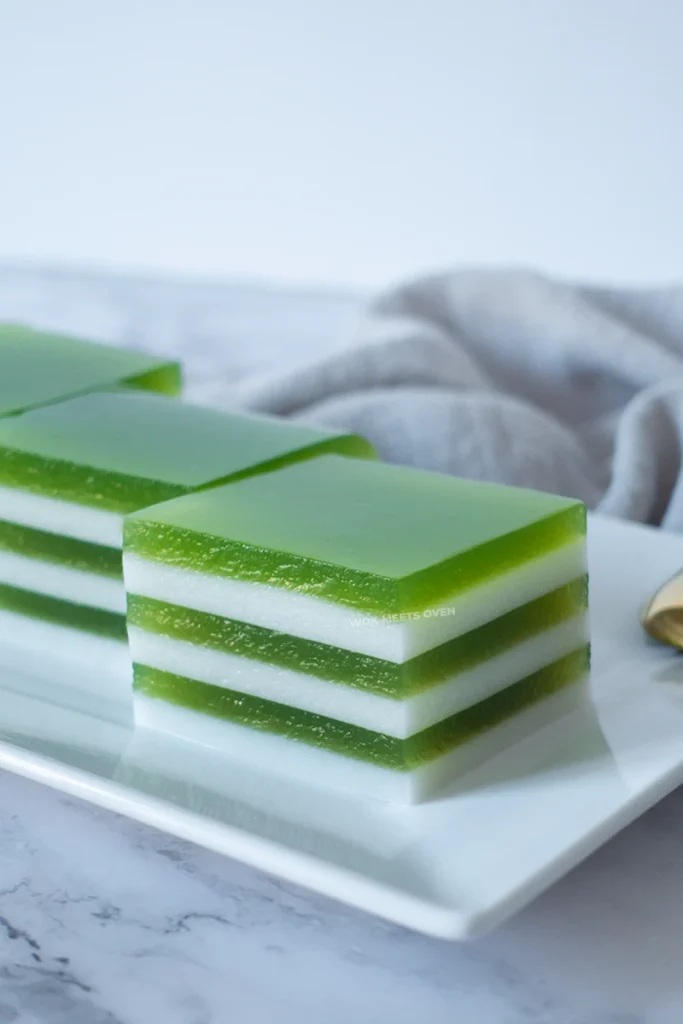
Tips
- Make sure to stir the liquid constantly in the pot, especially at the top to prevent the jelly from sticking to the bottom of the pot.
- Use a strainer when pouring out the liquid. This helps to remove bubbles and impurities from the top of the layer, making it look smooth and nice.
- Use a toothpick and spoon to pop and scoop out any bubbles to make the top of the layer look smooth.
- Pour the liquid close to the previous layer to prevent it from sinking down.
- Allow the layer underneath to cool down and become somewhat firm before pouring in the next layer. You can check for firmness by using your finger and pressing down very lightly.
- Keep both the coconut and Pandan liquid in the pots warm while pouring out the layers. This will help prevent the liquid from solidifying in the pots.
- if the liquid has started to solidify in the pot before you have time to pour it all out then reheat the pot back up on medium to medium-high heat then reduce the heat back to low once it has turned back into liquid form.
Common Mistakes Beginners Make
- Not allowing each layer enough time to set before pouring in the next layer which causes the layer underneath to sink down.
- Pouring in the mixture too high onto the previous layer which causes the layer underneath to sink down.
- Not heating and keeping the liquid warm prior to pouring it out which causes the liquid to solidify quickly.
Storage Tips
The Vietnamese Pandan coconut jelly dessert can be stored in the fridge in an airtight container for up to 1 week.
Frequently Asked Questions (F.A.Q.S)
Why Did My Layer Underneath Sink Down?
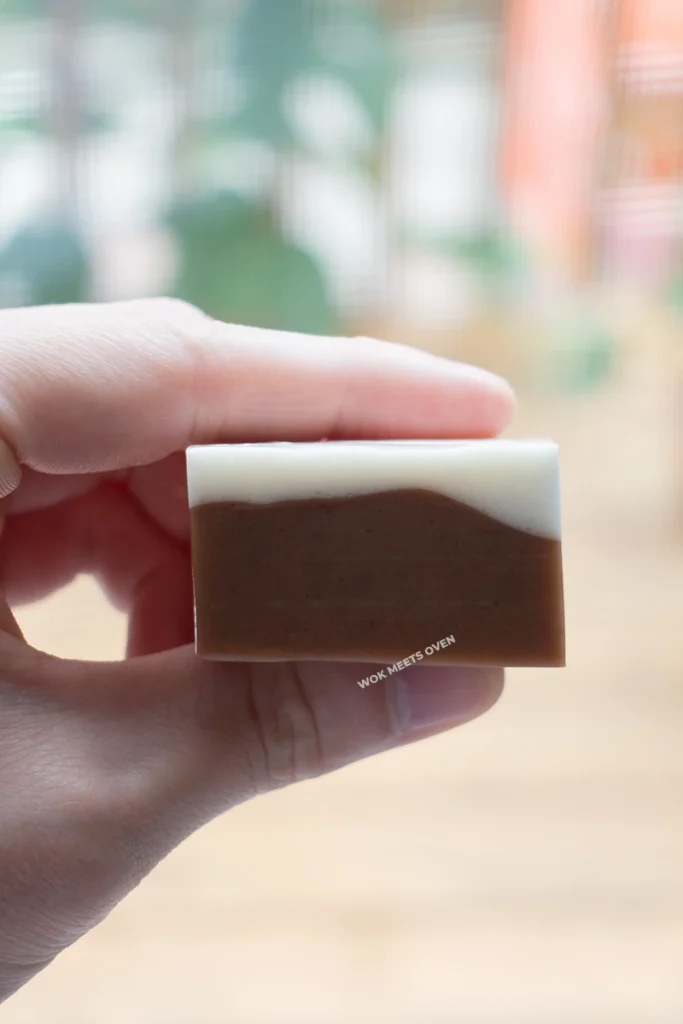
This is caused by 2 things:
- The layer underneath has not been given enough time to solidify yet and is still very fragile so when you pour the liquid on top, due to the weight of the new layer, it will cause the layer underneath to sink.
- You’re pouring the liquid too high onto the layer underneath, causing too much pressure and making it sink.
To remedy both of these issues, give each layer enough time to solidify and pour the next layer very close to the previous layer. You can gently tap the layer to check and see if it has hardened enough or not.
I have seen some people online claim that you should only allow the layer underneath to solidify slightly before pouring the next layer on by seeing if the layer slightly sticks to your finger otherwise if it becomes too hard, it will separate.
However, when I was testing this myself, I found that only having the top portion of the layer underneath slightly solidify was not enough to prevent it from sinking down. Instead, I suggest you give the layer enough time to become somewhat firm. I did not run across any issues with the layers underneath separating despite the layer underneath becoming somewhat firm prior to pouring the next layer on top.
Why Are My Layers Uneven?
If you want your layers to look even and nice, make sure that you use a kitchen scale to weigh out the liquid for each layer.
Why Is My Agar-Agar Liquid Solidifying So Quickly Before I Can Pour It Out?
The agar-agar liquid will start to solidify once it starts to cool down. Keep the agar-agar liquid heated on low to medium-low heat while pouring each layer out to prevent this from happening.
How Can I Make My Solidified Agar-Agar Liquid Again?
Just simply reheat the solidified agar-agar in a pot and it will slowly turn back into liquid form.
How Do I Make My Layers Look Nice?
To make your layers look nice, I recommend weighing the liquid prior to pouring it out to ensure each layer has equal portions and also to use a strainer when pouring the layers. This will help remove a lot of bubbles and impurities.
Can I Substitute Gelatin for Agar-Agar Powder?
No, this recipe was tested specifically with Agar agar powder and not gelatin. Gelatin is much softer and you run the risk of it sinking down when pouring in the next layer on top. Also, the water ratio for using gelatin and agar powder is different. Just stick with using agar agar powder, it’s cheaper too 😉.
How Do I Prevent My Jelly From Becoming Very Watery and Runny After Cutting It?
You can greatly reduce the amount of water that is released from the jelly when cutting into it by first allowing the agar-agar powder to hydrate and “bloom” in the pot for about 10 minutes or so with the water prior to heating it up over the stove.
Can I Use Just Pandan Extract Instead of Pandan Leaves?
Not really as the Pandan extract is meant more for cakes and pastries. It will lack that fragrance that you get from the Pandan leaves, not to mention making your food very green if you use too much of it. Instead, I recommend that you purchase canned Pandan juice which will oftentimes be labeled “Pandan leaves extract” (yeah I know, confusing right? 🤦♂️) if you really can’t find Pandan leaves for sale.
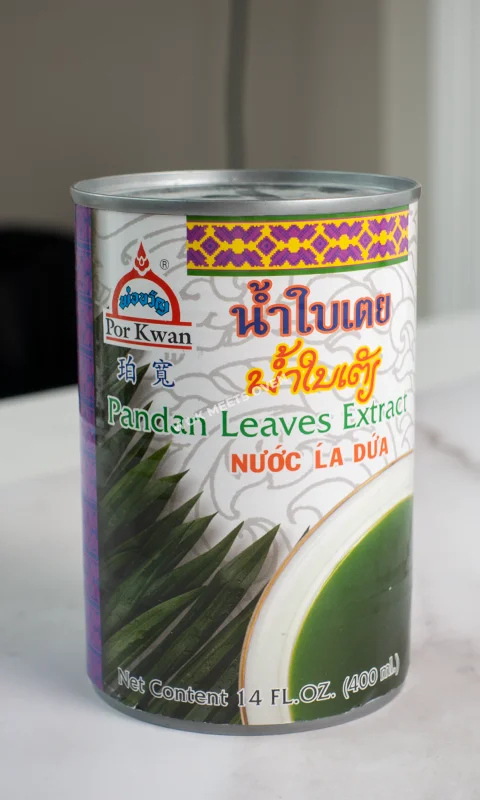
Other Recipes You’ll Love
- Milo Coconut Jelly
- Chinese Coconut Pudding
- Chrysanthemum Jelly
- Grass Jelly Dessert
- Vietnamese Corn Pudding (Chè Bắp)
You can pin this image
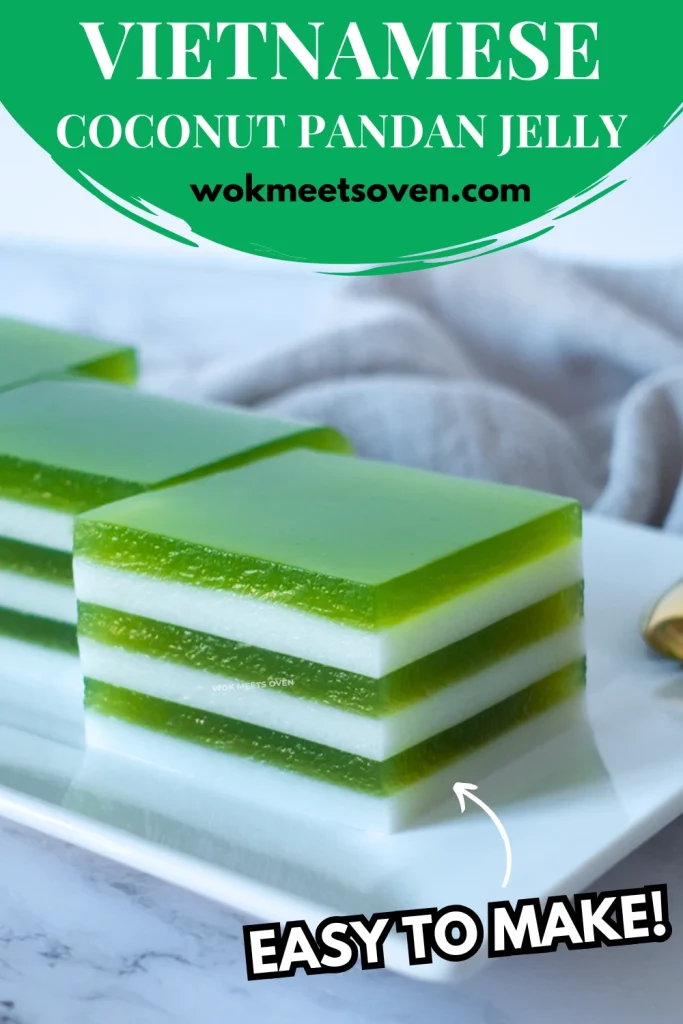
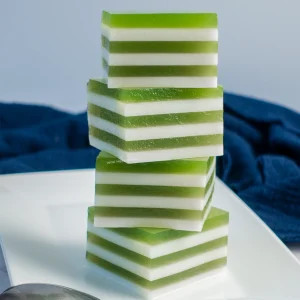
Vietnamese Coconut Pandan Jelly Dessert
Equipment
- 3 Pots
Ingredients
Agar-agar liquid mixture
- 25 g Agar-agar powder
- 1.6 Litres Water
- 300 g White granulated sugar
- 1/4 tsp Table salt
Coconut Layer
- 400 ml Coconut milk
- 850 ml Agar-agar liquid mixture Combine with coconut milk
Pandan Layer
- 50 g Pandan Leaves Washed
- 500 ml Water
- 750 ml Agar-agar liquid mixture Combine with Pandan juice
- 1-2 Drops Pandan Extract/Essence Optional
Instructions
- To start off, pour the agar agar powder and sugar onto a pot of water (1.6L) and let it soak for a few minutes (approximately 10-15 minutes) after whisking it with a whisk. You will end up with 1.6 Litres of agar-agar liquid mixture, which will be divided between the coconut milk and pandan juice layers later on.
- In another pot pour the coconut milk onto the pot and set it aside.
- Now add the Pandan leaves and 500ml of water into a blender and blend everything together. Then strain out the Pandan juice and pour it into a pot. Add 1-2 drops of pandan extract/essence and mix everything well together and set it aside.
- Next, heat up the pot with the agar agar powder from earlier until it boils and then turn off the stove.
- Now pour out 850ml of the agar agar liquid into the pot with coconut milk and 750ml of the agar agar liquid into the pot with the Pandan juice and mix well together.
- Place both of the pots onto the stove and turn on the stove. Heat up the pots and let them simmer while constantly stirring the pots.
- Once they start to simmer, reduce the heat to low to keep both of the pots warm.
- Now use a large measuring cup, and pour out around 200ml of the liquid from the Pandan juice pot onto a glass container. This will be our first layer.
- Now using a timer such as an app on your phone, time it for 10 minutes to allow the first layer to solidify. At the end of 10 minutes, check for firmness by gently tapping on the layer and see if it’s somewhat firm. If it’s firm, then you can proceed to the next step. If it’s not firm yet, give it some more time to become firm, and then adjust your timer countdown time accordingly for pouring out future layers.
- Next, pour out 200ml of the coconut liquid from the coconut pot on top of the Pandan layer and let it rest for about 10 minutes to solidify or whatever time you deemed was necessary from the previous step.
- Repeat these two steps until you have 6 layers in total (3 Pandan layers and 3 coconut layers).
- Leave the jelly outside until it cools down and then cover it with a lid and store it in the fridge to cool down, ideally overnight before serving or at least 4 hours before consuming.

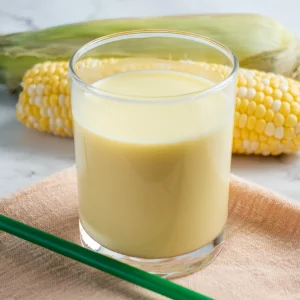
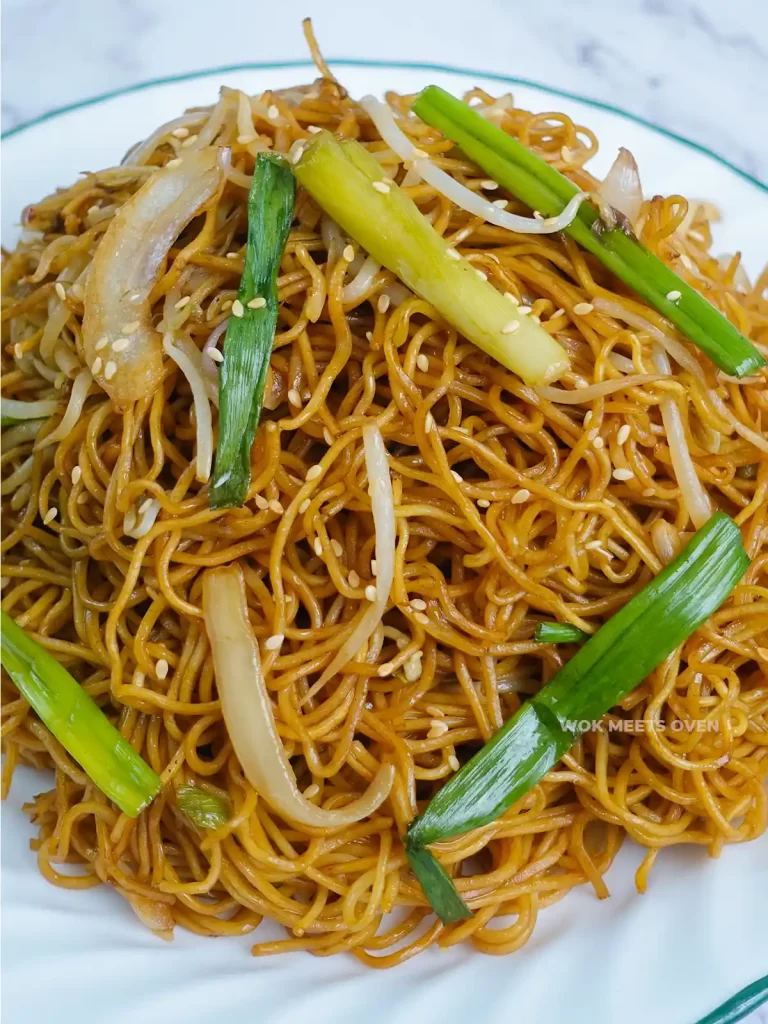
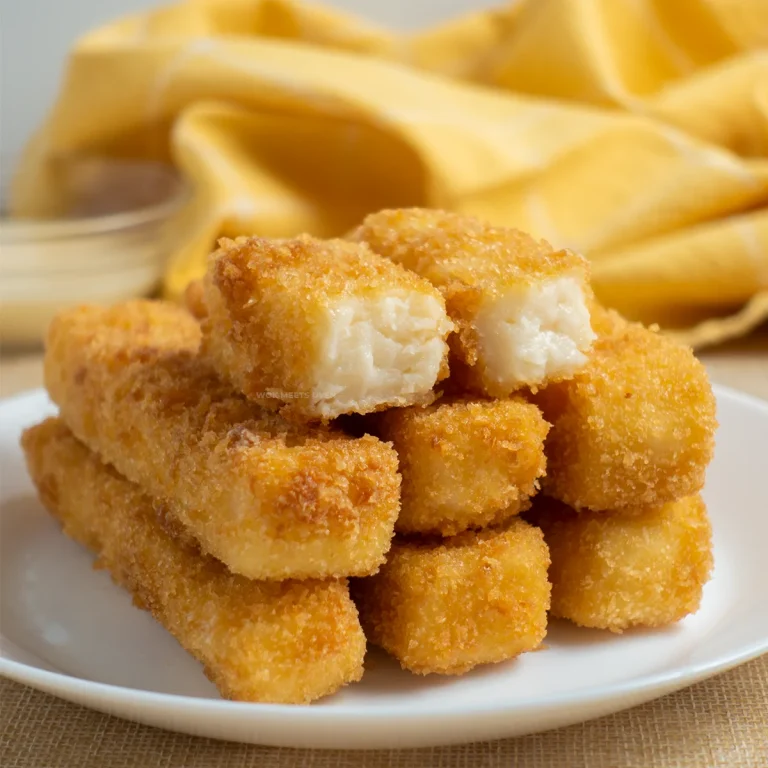

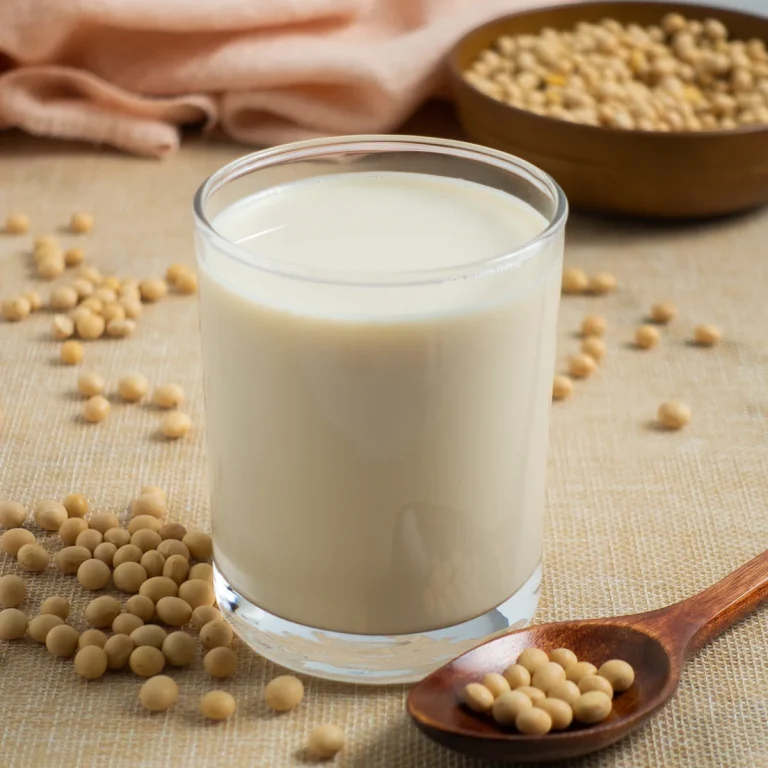
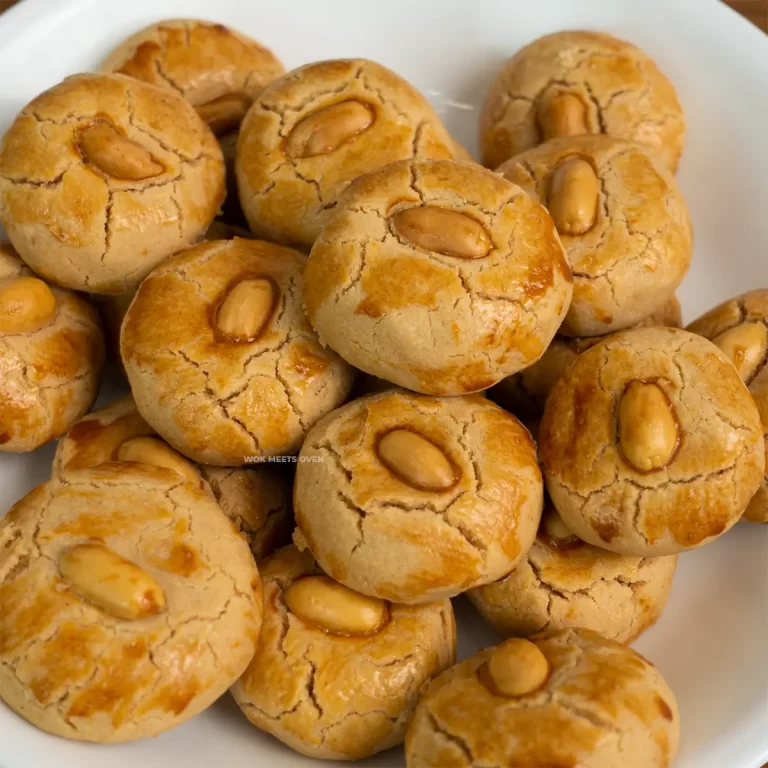
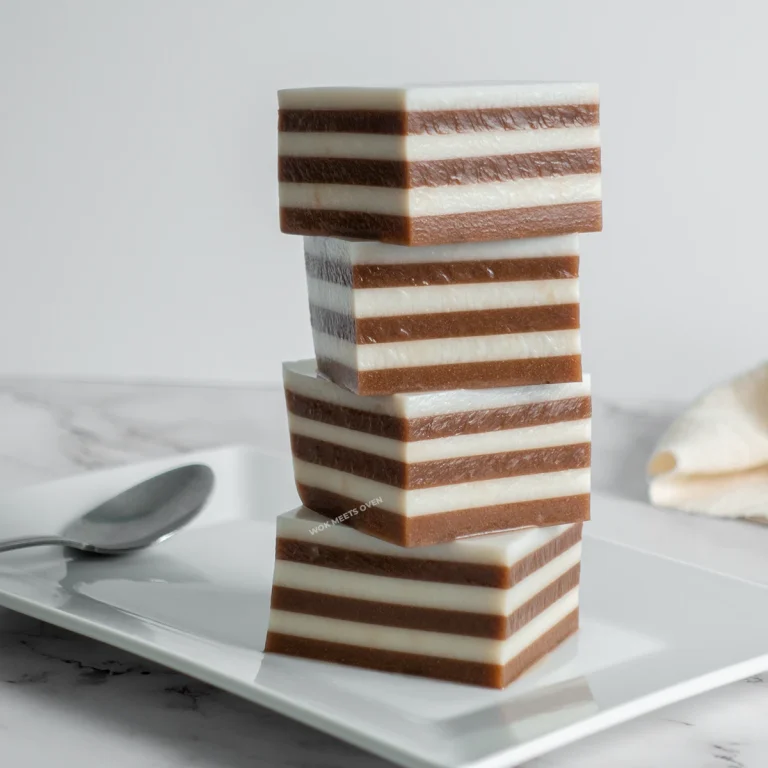
Very useful recipe ✨ Just a small suggestion, when we hear up 1.6 litres of water with the agar agar mixture, liquid is more than 850 ml and 750 ml for Coconut and pandan mixture. Hence made milo jelly with the remaining agar agar liquid.
Thank you for bringing this to my attention. I will try to make it more clear so there is no further confusion 😊